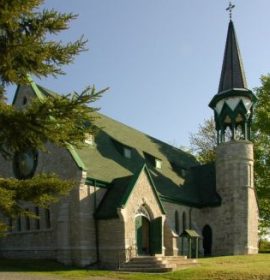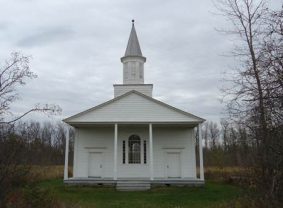
St. Alban the Martyr church in Adolphustown was built in 1884.
Click here for larger version.
Photo by Graem Coles.
St. Alban the Martyr Memorial Church stands by the side of the road, elevated on a rise of land, about 40 kilometres west of Kingston, in the quiet hamlet of Adolphustown. The church was built close to the landing site of the fourth town contingent of the United Empire Loyalist who arrived at Adolphustown Creek on June 16, 1784 and is dedicated to United Empire Loyalists.
Construction of this Gothic revival stone church began in 1884. The Honourable John Beverly Robinson, Lieutenant Governor of Ontario laid the cornerstone on June 17, 1884, during the Bay of Quinte Centennial Celebrations of the landing of the Loyalists. Construction lasted several years and the first service was held in the church June 25, 1890.
The minister serving the Adolphustown parish at the time St. Alban's was built was the Rev. Richard Sykes Forneri. The son of Italian political exiles who had received refuge in Ireland, Forneri was ordained at Trinity College, Toronto, in 1866 and assigned the ministry of the Adolphustown parish in 1883. Although his parishioners were never numerous, Forneri deemed the existing small wooden church unsuitable and envisioned his congregation worshiping in a fine new church. "The structure will be of stone, gothic architecture and will seat 200 people," he wrote.
Rev. Forneri had arrived to take up his duties just as plans for the 100th anniversary celebrations of the Loyalist landing in Adolphustown were getting underway. He was disheartened by the deterioration and neglect he observed in the small Loyalist cemetery which is presently located in the Adolphustown United Empire Loyalist Park, and has since been refurbished. He observed "tombstones crumbling under the action of weather."(1) Many names could no longer be discerned. As the son of Italian immigrant parents who had left their country as political refugees, Forneri had great empathy for the dislocation experienced by the early Loyalists and the courage and perseverance they had demonstrated in the face of great difficulties and he believed they deserved a more fitting and lasting memorial than crumbling tombstones. The idea of combining his dream of a new church for his parish and a memorial to the early Loyalists was born.
The Power's architectural firm chosen to design the new church was a father/sons team who from 1849 to 1930, built a number of impressive buildings that are still considered architectural landmarks in Kingston. The firm's work includes McIntosh Castle, the extension to St. George's Cathedral, the reconstruction and Dome enhancements to Kingston's City Hall and the Hotel Belvedere. St. Alban's has been described as "a jewel from the Power firm's oeuvre".
The church has many interesting features, including a marble baptismal font, flags that are replicas of the colours that the Queen's Rangers American Regiment carried during the American Revolution and a bell believed to be the oldest church bell in Canada. A vaulted wooden ceiling and intricately carved altar and pews are examples of superior craftsmanship and were an integral part of the planning and construction. Forneri also encouraged patrons to sponsor Memorial stained glass windows. Three windows were installed by 1890 and over the years, clear glass windows have been gradually replaced with beautiful stained glass. The final window, the large Rose Window on the west wall, was only completed in 2008. The window was designed and produced by the renowned Robert McCausland stained glass studio in Toronto where generations of McCausland artisans have been making windows for St. Alban's for over one hundred years.

Original Anglican Church in Adolphustowm circa 1822
(known as St. Paul's). The church has been restored and
re-erected in Demorestville, Prince Edward County.
Click here for larger version.
Photo by Ted Davie.
In England during the latter half of the Nineteenth Century, inscribed glazed tiles were sometimes used in churches to memorialize and honour prominent individuals and Rev. Forneri believed decorative memorial tiles commemorating early Loyalist would fit well into the interior of the new church. In a letter to a prospective donor he wrote that "beginning at the Chancel a band of coloured English tiles will run along the wall just above the wainscoting and in this band will be inserted polished tablets bearing the names of prominent Loyalists of Canada. There they will not, like their tombstones, crumble under the action of the weather. There they will be read with reverence by succeeding generations. Thus names which are historical will be lastingly preserved".(2) By 1890, the year services were first held in the church, thirty-three of the sixty-four tiles allowed for had been sponsored. The last of the 64 memorial tiles was mounted in 1909.
Rev. Forneri was by all accounts an intelligent and gentle soul but a man of great zeal and energy, undaunted by the great task he faced. A local businessman, J.J. Watson agreed to donate land for the new church and many parishioners and local residents made generous pledges in support of the project. Forneri also traveled extensively on foot, by horse or by boat to areas around the Bay of Quinte and to Ottawa and Montreal in his search for donors. He preached tirelessly when he traveled and usually returned with new pledges of support. Fortunately, Albert Loft Geen, a lay reader and brother-in-law residing in Belleville, took over the services for most of the time Forneri was away. Geen traveled back and forth from Belleville (a long, difficult journey in those days) without compensation, so that Forneri could be free to raise the funds for the new church. It seems nothing short of a miracle that in less than a year he had pledges for the estimated $8,000 needed before construction could begin.
It was not just the building itself that occupied Rev. Forneri. He wrote hopefully to a patron in 1888 that he wished to raise $1,000 to insure "an annual sermon, lecture or oration upon the subject (the Loyalists example of devotion) by some select speaker of ability. Not until I have accomplished this shall I feel that I have done all I can do to keep evergreen the Memory of the Fathers of our Country - not until this is affected shall I consider the church complete". On the Sunday closest to the landing date, we at St. Alban's still hold an annual UEL Memorial Service.
The present St. Alban's Church, constructed of local stone, replaced an earlier wooden structure known as St. Paul's, which had been built between 1820 and 1823 and consecrated in 1830 by the Rt. Rev. Charles James Stuart, Lord Bishop of Quebec. Before 1823, the small congregation (only twenty per cent of the 72 families in the small landing party of Adolphuston Loyalists were Church of England adherents) met in the Hagerman house, which was located in the western end of what is now the United Empire Loyalist Park. The earlier wooden church was situated nearby, just a little to the west of the present church. The old church was taken down board by board in 1997, moved and rebuilt in its original design by Dr. Brisley near his home in Demorestville.
The congregation of St. Alban's Church was disestablished in 2018. Concerned about the future of the church, a group of local residents formed a charity with a vision of preserving the church and promoting its use within community. Please visit the St. Alban's Centre website for further information.
The well-maintained St. Alban's Cemetery remains active.
To learn more, please see Contact Information.

